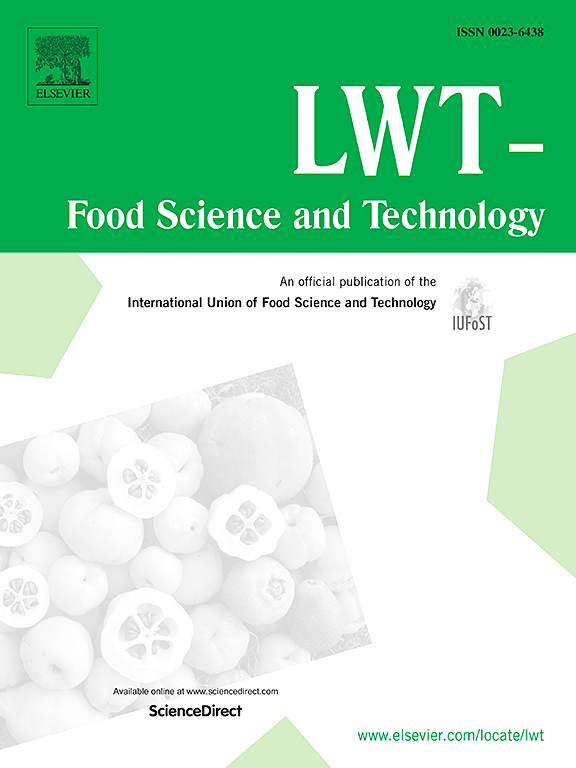Enhancing ice cream quality with dietary fiber and spore-forming probiotics: A study on Shouchella clausii and Heyndrickxia coagulans
IF 6
1区 农林科学
Q1 FOOD SCIENCE & TECHNOLOGY
引用次数: 0
Abstract
This study aimed to assess the potential positive impact of incorporating milk fermented with dietary fiber (wheat fiber and inulin) and spore-forming probiotics (Shouchella clausii and Heyndrickxia coagulans) on ice cream quality during 90 days at −25 °C. Ice cream formulations combined fermented and non-fermented ingredients. Viable cell and spore counts, sensory, physical, chemical, and thermal properties, and energy content were analyzed. Probiotic cultures remained viable in both vegetative and spore forms. Throughout storage, probiotic ice creams with S. clausii showed higher viable cell counts (≥8.25 log CFU/g) than those with H. coagulans. Among formulations, inulin-enhanced S. clausii ice cream had the highest viability, maintaining the best survival rate on day 90. All samples received equivalent scores for general acceptability, with a mean score of 7.45 for taste and smell, indicating no compromise in sensory quality. The fibers increased viscosity, affected melting time, and influenced fat destabilization, with wheat fiber contributing to increased hardness. Probiotic ice creams, whether fiber-enriched or fiber-free, had balanced calorie content comparable to standard ice cream, indicating potential for healthier dessert options. These findings highlight the potential of spore-forming probiotics and dietary fibers in developing functional ice creams with health benefits and high sensory quality.
利用膳食纤维和孢子形成益生菌提高冰淇淋质量:关于克劳氏寿昌菌和凝结球菌的研究
本研究旨在评估牛奶中加入膳食纤维(小麦纤维和菊粉)和孢子形成益生菌(克氏寿氏菌和凝结球菌)发酵后,在 -25 °C 下 90 天内对冰淇淋质量的潜在积极影响。冰淇淋配方结合了发酵和非发酵成分。对存活细胞和孢子数量、感官、物理、化学和热特性以及能量含量进行了分析。益生菌培养物以无性和孢子两种形式保持存活。在整个储存过程中,含有 S. clausii 的益生菌冰淇淋比含有 H. coagulans 的冰淇淋显示出更高的存活细胞数(≥8.25 log CFU/g)。在各种配方中,菊粉增强型克劳斯氏菌冰淇淋的存活率最高,在第 90 天的存活率也最高。所有样品的总体可接受性得分相当,口感和气味的平均得分为 7.45 分,表明感官质量没有受到影响。纤维增加了粘度,影响了融化时间,并影响了脂肪的不稳定性,其中小麦纤维增加了硬度。无论是富含纤维还是不含纤维的益生菌冰淇淋,其卡路里含量都与标准冰淇淋相当,这表明益生菌冰淇淋有可能成为更健康的甜点选择。这些发现凸显了芽孢益生菌和膳食纤维在开发有益健康和高感官质量的功能性冰淇淋方面的潜力。
本文章由计算机程序翻译,如有差异,请以英文原文为准。
求助全文
约1分钟内获得全文
求助全文
来源期刊

LWT - Food Science and Technology
工程技术-食品科技
CiteScore
11.80
自引率
6.70%
发文量
1724
审稿时长
65 days
期刊介绍:
LWT - Food Science and Technology is an international journal that publishes innovative papers in the fields of food chemistry, biochemistry, microbiology, technology and nutrition. The work described should be innovative either in the approach or in the methods used. The significance of the results either for the science community or for the food industry must also be specified. Contributions written in English are welcomed in the form of review articles, short reviews, research papers, and research notes. Papers featuring animal trials and cell cultures are outside the scope of the journal and will not be considered for publication.
 求助内容:
求助内容: 应助结果提醒方式:
应助结果提醒方式:


